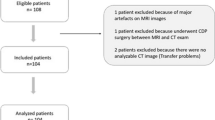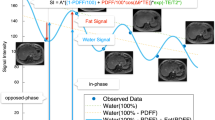Abstract
Reflecting the growing interest in early diagnosis of non-alcoholic fatty liver disease in recent years, the development of noninvasive and reliable fat quantification methods is needed. Dual-energy computed tomography (DE-CT) is a quantitative diagnostic imaging method that estimates the composition of the imaging target using a material decomposition technique based on the X-ray absorption characteristics peculiar to substances from DE-CT scanning using X-rays generated with different energies (tube voltage). In this review article, we first explain the basic principles and technical aspects of DE-CT. Then, we will present the current diagnostic ability of DE-CT and the factors influencing the quantitative evaluation of liver steatosis using DE-CT as compared to multi-modal methods including ultrasound and magnetic resonance imaging-based methods. In brief, DE-CT may have comparable diagnostic performance to the modern US-based liver fat measurement methods. However, the current material decomposition technique using DE-CT does not seem to have added value to the simple quantitative assessment of liver steatosis, because DE-CT measurement does not improve the accuracy of fat quantification over conventional single-energy computed tomography (SE-CT) attenuation. The most significant influencing factor for the quantitative assessment of liver steatosis using DE-CT can be hepatic iron deposition. An iron-specific multi-material decomposition algorithm correcting for the influences of iron in the liver has been under development. The current material decomposition algorithm can still have added value in a specific situation such as the quantitative assessment of liver steatosis using contrast-enhanced DE-CT. However, there is a lack of evidence for the influence of liver fibrosis in the quantitative assessment of liver steatosis using DE-CT.





Similar content being viewed by others
References
Anstee QM, Reeves HL, Kotsiliti E, et al. From NASH to HCC: current concepts and future challenges. Nat Rev Gastroenterol Hepatol. 2019;16:411–28.
Kose S, Ersan G, Tatar B, et al. Evaluation of percutaneous liver biopsy complications in patients with chronic viral hepatitis. Eurasian J Med. 2015;47:161.
Ratziu V, Charlotte F, Heurtier A, et al. Sampling variability of liver biopsy in nonalcoholic fatty liver disease. Gastroenterology. 2005;128:1898–906.
Regev A, Berho M, Jeffers LJ, et al. Sampling error and interobserver variation in liver biopsy in patients with chronic HCV infection. Am J Gastroenterology. 2002;97:2614–8.
Ferraioli G, Soares Monteiro LB. Ultrasound-based techniques for the diagnosis of liver steatosis. World J Gastroenterol. 2019;25:6053–62.
Kramer H, Pickhardt PJ, Kliewer MA, et al. Accuracy of liver fat 1uantification with advanced CT, MRI, and ultrasound techniques: prospective comparison with MR spectroscopy. AJR Am J Roentgenol. 2017;208:92–100.
Li Q, Dhyani M, Grajo JR, et al. Current status of imaging in nonalcoholic fatty liver disease. World J Hepatol. 2018;10:530–42.
Rutherford RA, Pullan BR, Isherwood I. Measurement of effective atomic number and electron density using an EMI scanner. Neuroradiology. 1976;11:15–21.
Kruger RA, Riederer SJ, Mistretta CA. Relative properties of tomography, K-edge imaging, and K-edge tomography. Med Phys. 1977;4:244–9.
McCollough CH, Leng S, Yu L, et al. Dual- and multi-energy CT: principles, technical approaches, and clinical applications. Radiology. 2015;276:637–53.
Patino M, Prochowski A, Agrawal MD, et al. Material separation using dual-energy CT: current and emerging applications. Radiographics. 2016;36:1087–105.
Johnson TR. Dual-energy CT: general principles. Am J Roentgenol. 2012;199:S3–8.
Lohr TG, McCollough CH, Bruder H, et al. First performance evaluation of a dual-source CT (DSCT) system. Eur Radiol. 2006;16:256–68.
Rassouli N, Etesami M, Dhanantwari A, et al. Detector-based spectral CT with a novel dual-layer technology: principles and applications. Insights Imaging. 2017;8:589–98.
Primak AN, Giraldo JCR, Eusemann CD, et al. Dual-source dual-energy CT with additional tin filtration: dose and image quality evaluation in phantoms and in vivo. AJR Am J Roentgenol. 2010;195:1164–74.
Wu E-H, Kim SY, Wang ZJ, et al. Appearance and frequency of gas interface artifacts involving small bowel on rapid-voltage-switching dual-energy CT iodine-density images. Am J Roentgenol. 2016;206:301–6.
Li JH, Tsai CY, Huang HM. Assessment of hepatic fatty infiltration using dual- energy computed tomography: a phantom study. Physiol Meas. 2014;35:597–606.
Korkusuz H, Abbas Raschidi B, Keese D, et al. Diagnosing and quantification of acute alcohol intoxication–comparison of dual-energy CT with biochemical analysis: initial experience. Rofo. 2012;184:1126–30.
Itaya S, Matsui T, Kamiyama T, et al. Evaluation of fat quantification in the liver using dual energy CT. Nihon Hoshasen Gijutsu Gakkai Zasshi. 2016;72:1084–90.
Artz NS, Hines CD, Brunner ST, et al. Quantification of hepatic steatosis with dual-energy computed tomography: comparison with tissue reference standards and quantitative magnetic resonance imaging in the ob/ob mouse. Invest Radiol. 2012;47:603–10.
Kramer H, Pickhardt PJ, Kliewer MA, et al. Accuracy of liver fat quantification with advanced CT, MRI, and ultrasound techniques: prospective comparison with MR spectroscopy. AJR Am J Roentgenol. 2017;208:92–100.
Uhrig M, Mueller J, Longerich T, et al. Susceptibility based multiparametric quantification of liver disease: non-invasive evaluation of steatosis and iron overload. Magn Reson Imaging. 2019;63:114–22.
Zeng Q, Song Z, Zhao Y, et al. Controlled attenuation parameter by vibration-controlled transient elastography for steatosis assessment in members of the public undergoing regular health checkups with reference to magnetic resonance imaging-based proton density fat fraction. Hepatol Res. 2020;50:578–87.
Ferraioli G, Maiocchi L, Savietto G, et al. Performance of the attenuation imaging technology in the detection of liver steatosis. J Ultrasound Med. 2021;40:1325–32.
Patel BN, Kumbla RA, Berland LL, et al. Material density hepatic steatosis quantification on intravenous contrast-enhanced rapid kilovolt (peak)-switching single-source dual-energy computed tomography. J Comput Assist Tomogr. 2013;37:904–10.
Hyodo T, Yada N, Hori M, et al. Multimaterial decomposition algorithm for the quantification of liver fat content by using fast-kilovolt-peak switching dual-energy CT: clinical evaluation. Radiology. 2017;201:108–18.
Hyodo T, Hori M, Lamb P, et al. Multimaterial decomposition algorithm for the quantification of liver fat content by using fast-kilovolt-peak switching dual-energy CT: experimental validation. Radiology. 2017;282:381–9.
Fischer MA, Gnannt R, Raptis D, et al. Quantification of liver fat in the presence of iron and iodine: an ex-vivo dual-energy CT study. Invest Radiol. 2011;46:351–8.
Peng Y, Ye J, Liu C, et al. Simultaneous hepatic iron and fat quantification with dual-energy CT in a rabbit model of coexisting iron and fat. Quant Imaging Med Surg. 2021;11:2001–12.
Xie T, Li Y, He G, et al. The influence of liver fat deposition on the quantification of the liver-iron fraction using fast-kilovolt-peak switching dual-energy CT imaging and material decomposition technique: an in vitro experimental study. Quant Imaging Med Surg. 2019;9:654–61.
Fischer MA, Reiner CS, Raptis D, et al. Quantification of liver iron content with CT-added value of dual-energy. Eur Radiol. 2011;21:1727–32.
Doda Khera R, Homayounieh F, Lades F, et al. Can dual-energy computed tomography quantitative analysis and radiomics differentiate normal liver from hepatic steatosis and cirrhosis? J Comput Assist Tomogr. 2020;44:223–9.
Author information
Authors and Affiliations
Corresponding author
Ethics declarations
Conflict of Interest
Akira Yamada declares that he has no conflicts of interest. Eriko Yoshizawa declares that she has no conflicts of interest.
Ethical statements
There is no ethical statement applicable to this review article.
Additional information
Publisher's Note
Springer Nature remains neutral with regard to jurisdictional claims in published maps and institutional affiliations.
About this article
Cite this article
Yamada, A., Yoshizawa, E. Quantitative assessment of liver steatosis using ultrasound: dual-energy CT. J Med Ultrasonics 48, 507–514 (2021). https://doi.org/10.1007/s10396-021-01136-9
Received:
Accepted:
Published:
Issue Date:
DOI: https://doi.org/10.1007/s10396-021-01136-9




